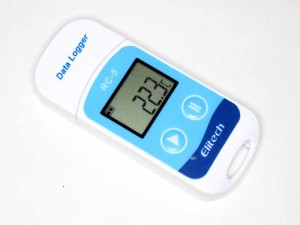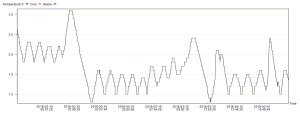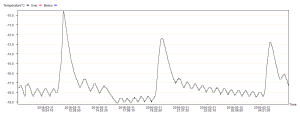The operating temperatures of refrigerators and freezers used for food storage is important to safe storage of food and to minimisation of energy costs.
The US FDA recommends the refrigerator should be set to 40F (4.4°) and the freezer to 0F (-17.8°).
Temperatures vary inside the cabinets, and they vary over time with opening and closing doors, and introduction of warmer goods for storage.
Many spot temperature checks are helpful but they don’t provide a very complete picture, and opening the door to make measurements disturbs the very thing being measured.
Strategy
The following strategy has been trialled and tweaked, and appears sound:
- ensure there is free flow of air in cabinets;
- defrost if there is ice build up (ice insulates the evaporator and reduces refrigeration capacity);
- clean the condenser and compressor and make sure there is free air movement around them (poor cooling of the condenser increases head pressure, reduces efficiency and reduces refrigeration capacity);
- set the refrigerator thermostat so the bottom of the cabinet never goes below 1°, so reducing the risk of spoilage by freezing of sensitive product like lettuce;
- set the freezer thermostat for an average temperature of -18°; and
- leverage modern technology to get the ‘big picture’.
Above is the inexpensive (A$22 posted on eBay) temperature logger that was used for the measurements reported here. This can record 32,000 observations which could be every 10s for more than three days.
Perform initial tuning on warm but not excessively hot days, you want the system to work within its refrigeration capacity whilst adjusting the temperature regulation.
Above, after several tuning adjustments to the thermostat and settling time, the refrigerator lower cabinet temperature over a day. One can see the impact of door opening at meal times. Note that though this sets a safe temperature for storing product, the cold air inlet can get quite colder than this and sensitive product should not be located in this ‘cool down’ area of the cabinet.
Above, after several tuning adjustments to the thermostat and settling time, the freezer cabinet temperature over a day. One can see the impact of door opening at meal times. The ‘rogue’ increase at around 05:00 is the automatic defrost cycle.
Having found the appropriate settings, a small mark was made on each control as they are easily disturbed if bumped by jars etc… a really bad design.
Complications
Some Fridge/Freezers do not have an independent control for the freezer temperature, or freezer temperature might interact with refrigerator temperature, so be prepared for an iterative process in tuning.
Some freezer only cabinets may not have an obvious thermostat, it may be accessible at the rear near the compressor… but there is probably an accessible thermostat.
Allow time for the cabinet temperature to stabilise after tuning the thermostat.
If ambient temperatures are high and / or a lot of warm product added, the refrigeration capacity might be exceeded and it will take a very long time to cool down.


